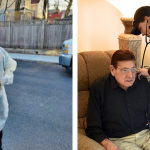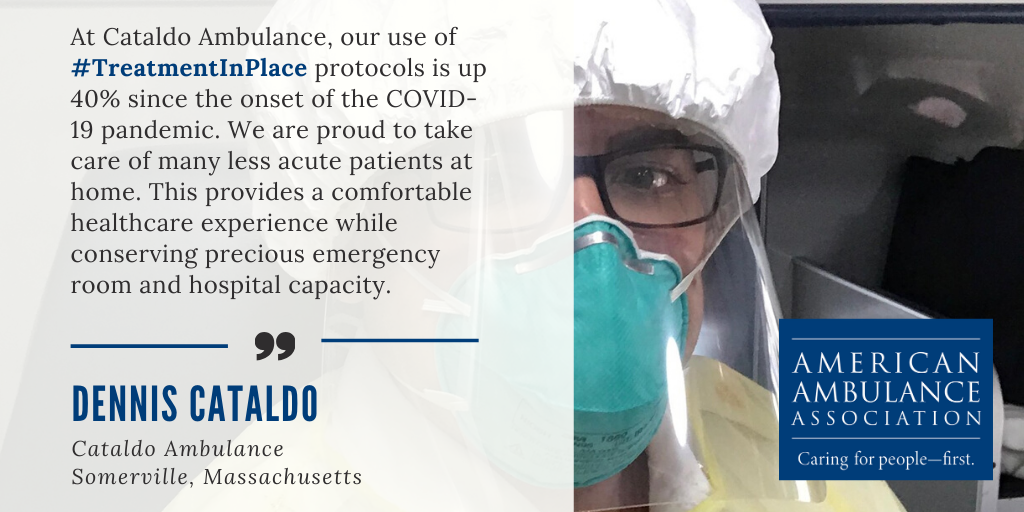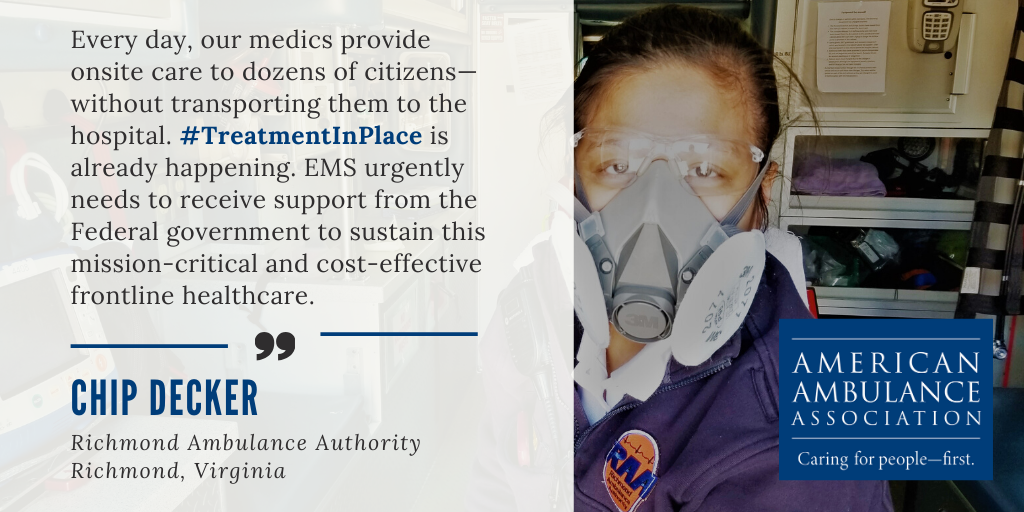
Treatment In Place
EMS Is Already Treating Patients In Place
It is time to fairly compensate providers for this safe, convenient, and cost-effective mobile healthcare.
One of the American Ambulance Association’s top priorities is to ensure that Medicare policies support getting patients to the right care location in the right way. Medicare is the dominant payer of ground ambulance services. This fact means that Medicare has a disproportionate impact on the ability of ground ambulance entities to stay open. If Medicare does not pay for certain services when the volume of those services are increasing exponentially, the ability of ground ambulance suppliers to continuing providing services is at substantial risk.
Therefore, it is critically important that Medicare pays ambulance services for recent adjustments to ground ambulance services as required by public health authorities and hospitals to address the hospital surge and other challenges during the COVID-19 Public Health Emergency (PHE). The AAA is pleased that CMS has recognized through the Interim Final Rule that ground ambulances need to be paid for taking patients to locations other than hospitals, Critical Access Hospitals (CAHs), and Skilled Nursing Facilities (SNFs.) We urge CMS to maintain the policy as proposed.
Treatment in Place
Ground ambulance services also need to be paid for caring for patients in their homes when it is no longer safe or appropriate given the surge of patients seeking hospital care. While the following examples are from New York , ground ambulance organizations across the country are being asked to do the same.
- Responding to cardiac arrests that are COVID-19 related. These patients are not being transported and require a high level of services and are costly.
- Treating respiratory and diabetic patients (some who have COVID-19 and some who do not) in the home to reduce hospital surge and reduce the risk that those who are not infected do not become exposed in a health care facility, given the higher risk these patients face.
- Providing Narcan for overdosed patients who can remain at home to safely recover in an effort to reduce hospital surge and additional risk to the patient.
- Treating patients who are syncope and/or dehydrated and who can remain at home to safely recover in an effort to reduce hospital surge and additional risk to the patient.
- Treating routine chronic seizures and referring patients to their neurologist rather than the hospital.
The bottom line is that public health authorities and hospitals are telling ground ambulance organizations not to transport any low- or mid-acuity patients to them. In addition, some primary care physicians are refusing to see patients and having them call 911 or the equivalent emergency line to be treated by ambulance personnel. Sometimes it is appropriate to transport patients alterative destinations, but that is not always the right location for a patient.
The burden this is creating on ground ambulance services is enormous. For example, the treatment in place rate in New York City for one ambulance service under this policy is 35 percent. Medicare should recognize the barrier and burden that the transportation requirement creates and remove it during the PHE.
Suggested Waivers for Treatment in Place
During the PHE, waive the restrictions limiting the definitions of Advanced Life Support, Level 1 (ALS1) and Basic Life Support (BLS) to transport at 42 C.F.R. § 414.605 and the transportation portion of the medical necessity requirements at 42 C.F.R. § 410.40 so that the beneficiary’s condition requires the level of service provided to allow for a payment to a ground ambulance organization that engages in treatment in place that is equivalent to the emergency BLS-E or ALS1-E rate, determined by the level of service rendered by the ground ambulance organization, without requiring the ground ambulance organization to transport the patient from the scene of the ambulance response, in order to address the COVID-19 PHE.
Like the alternative destination policy, the treatment in place services provided must be consistent with Emergency Medical Services (EMS) protocols established by state and/or local laws where the services will be furnished. The EMS protocols are recognized operating procedures that all emergency service professionals such as emergency medical technicians (EMTs) and paramedics must follow for patient assessment, treatment, transportation and delivery to definitive care. These protocols are designed by national, state and/or local medical authorities and institutions. Based on these protocols, a patient suspected of having COVID-19 may be tested or receive treatment at the site instead of being transported in an effort to prevent possible exposure to other patients and medical staff.
Telehealth
Addressing the question of transport in the current regulatory definition of medical necessity would address the issue of allowing ground ambulance providers and suppliers to provide telehealth services. While the Congress has opened up telehealth to all providers regardless of where the patient lives, CMS needs to clarify that ground ambulance entities will be paid for facilitating telehealth as well. The Congress has allowed CMS to waive all of the provisions of SSA § 1834(m) to reduce unnecessary contact between patients and health care professionals during this crisis. The broad waiver should also apply to ground ambulance organizations by recognizing them as legitimate originating sites and reimbursing them as an originating site for the telehealth services they facilitate. CMS has recognize the ability of ground ambulance services to play this role in telehealth in its Emergency Triage, Treat, and Transport (ET3) Model and has waived the payment restrictions as part of the pilot. This pilot, however, primarily includes urban providers who were able to meet other requirements of the model and does not address the burdens that all ground ambulances – urban and rural – are being asked to carry during this crisis.
As with Treatment in Place, ground ambulance services are being asked to act as an originating site for telehealth services in patients’ homes or at the scene to assist during the crisis. To play this role, paramedics and EMTs are being placed in harm’s way, require PPE, and are unable to respond to other calls. Without payment, ground ambulance services will not be able to cover their costs and may have to refuse providing them or risk closing their doors. Thus, during the COVID-19 PHE, CMS should apply this waiver to all ground ambulance services.
Suggest Waiver for Telehealth
CMS should also allow ground ambulance services to bill as the originating site for facilitating telehealth services with a practitioner listed in 42 C.F.R. § 410.78(b)(2) for the duration of the PHE.
Allow for a payment to ground ambulance organizations of a modified originating site facility fee equal to either the BLS-E or ALS1-E rate, determined by the level of service rendered by the ground ambulance organizations to address the costs and services to address the COVID-19 PHE.




